Benefits of Employee Monitoring

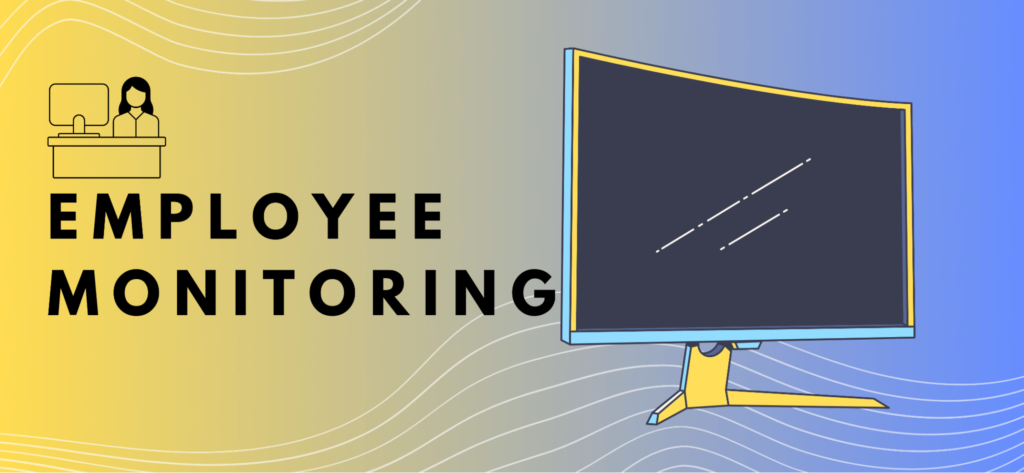
Are you being watched at work? Employee monitoring has become a hot topic in modern workplaces, with employers using advanced technology to track and monitor their employees’ every move. But is it an invasion of privacy or a necessary practice to ensure productivity?
According to a survey conducted by the American Management Association, 43% of companies in the U.S. monitor their employees’ email and other electronic communications.
Monitoring also affects employee productivity. As research shows that productivity among employees increases by 7% when they are aware of being monitored, resulting in higher profits.
In this blog, we’ll explore the pros and cons of employee monitoring and discuss the benefits that employers claim to gain from implementing such measures. So, are you ready to dive into the world of workplace surveillance? Further, we will add more statistics on monitoring employees.
Employee Monitoring: What It Is?
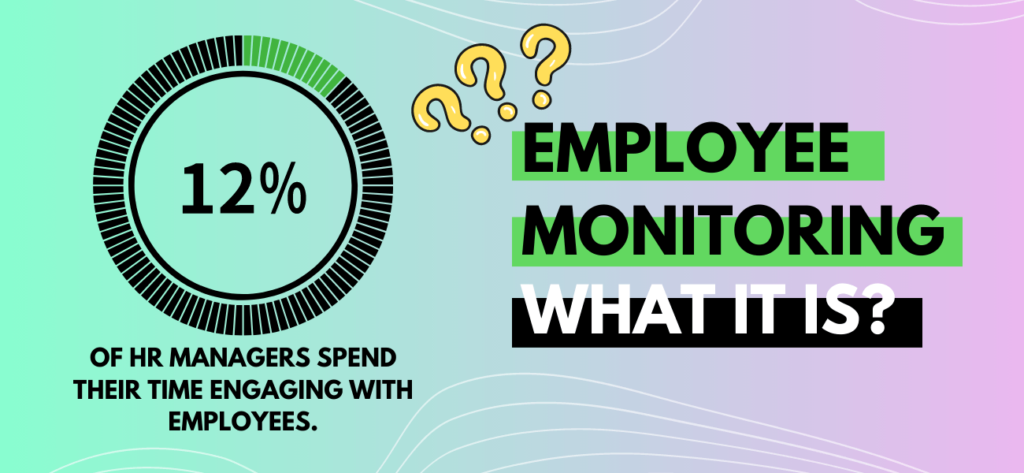
If you are a Human Resource manager, then it is not a new term for you. You might be spending the majority of your time monitoring your employees. According to the Emplicity website, HR managers spend 12% of their time engaging with employees. You are probably one of them.
Let me add to your knowledge, employee monitoring, as the name suggests, refers to the practice of monitoring and tracking the activities of employees in the workplace. As a manager, you might want to know your employees’ activities; what they do in the workplace when they do not perform their tasks.
Monitoring can include various methods such as monitoring employee internet use, tracking internet browsing, recording phone calls, monitoring emails, and even using video surveillance.
Why do you need to monitor your employees, by the way? You need to monitor your employees’ activities to ensure that employees are performing their duties efficiently, following company policies, and adhering to legal and ethical standards. Simply, employees should work with a dedicated focus when they are in the workplace. That is it.
In recent years, employee monitoring has become a controversial topic with debates on the balance between the benefits of monitoring and the invasion of employee privacy. However, when implemented properly and ethically, employee monitoring can provide several benefits to organizations. We will discuss both pros and cons of employee monitoring later in the article. Keep scrolling!
Why Employee Monitoring Is So Important?
You might have understood why managers monitor employees in the workplace. In today’s fast-paced business environment, employers need to ensure that their employees are productive, efficient, and compliant with company policies. Employee workplace monitoring plays a vital role in achieving these objectives. By tracking and analyzing employees’ activities, employers or managers can gain insights into how their workforce operates, identify areas for improvement, and address any performance issues proactively.
Further to it, monitoring employees helps organizations comply with legal and regulatory requirements, safeguard sensitive information, and protect their reputations from potential risks associated with insider threats or data breaches.
In the next part of the blog, we will discuss how employee monitoring can help organizations improve employee productivity.
Get more out of your business
Get the best employee engagement content every week via mailing list
Employee Monitoring: Major Benefits
As mentioned above, if you are an HR manager or a business owner, you understand the importance of ensuring that your employees are performing their duties efficiently, following company policies, and adhering to legal and ethical standards. This is where employee monitoring can play a crucial role.
Employee monitoring offers several benefits to organizations, including increased productivity, enhanced security, prevention of insider threats, compliance with legal requirements, promotion of ethical standards, performance evaluation, resource optimization, training and development, employee safety, evidence for dispute resolution, and many more.
Let’s read each in a bit of detail:
1. Increased Productivity
As a human resource manager, you might have asked yourself “Does employee monitoring increase productivity?” right? Research shows that it does. When employees are aware that their activities are being monitored, their productivity tends to increase by 7%, resulting in higher profits for the organization; they tend to stay focused on their tasks and minimize time-wasting activities. Of course, there might be many other ways to increase employee productivity, but monitoring is one of them.
According to another study conducted by the American Management Association, organizations that implemented employee monitoring reported an average productivity increase of 22%. This shows that when employees know that their performance is being monitored, they are more likely to stay on track and complete their tasks efficiently, leading to higher productivity levels.
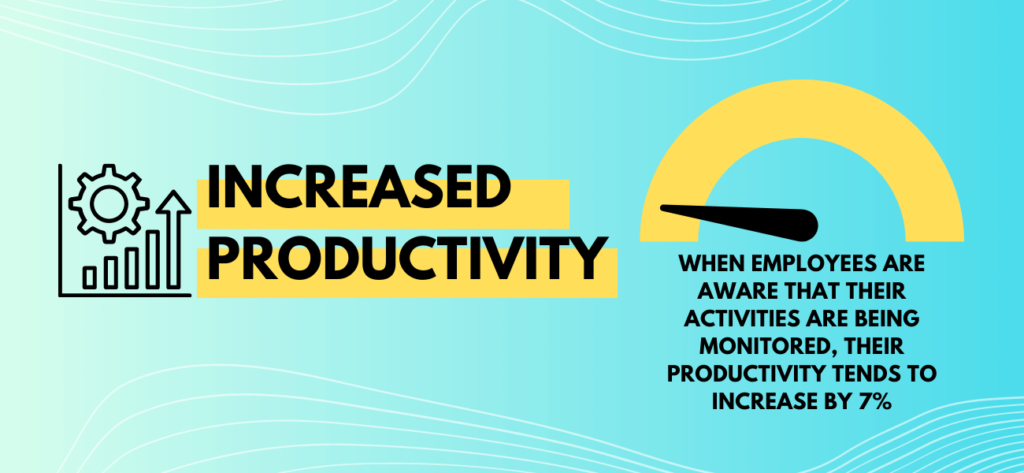
2. Enhanced Security
Approximately 45% of companies in the United States have encountered a data breach, indicating a significant portion of businesses have fallen victim to unauthorized access or exposure of their digital information.
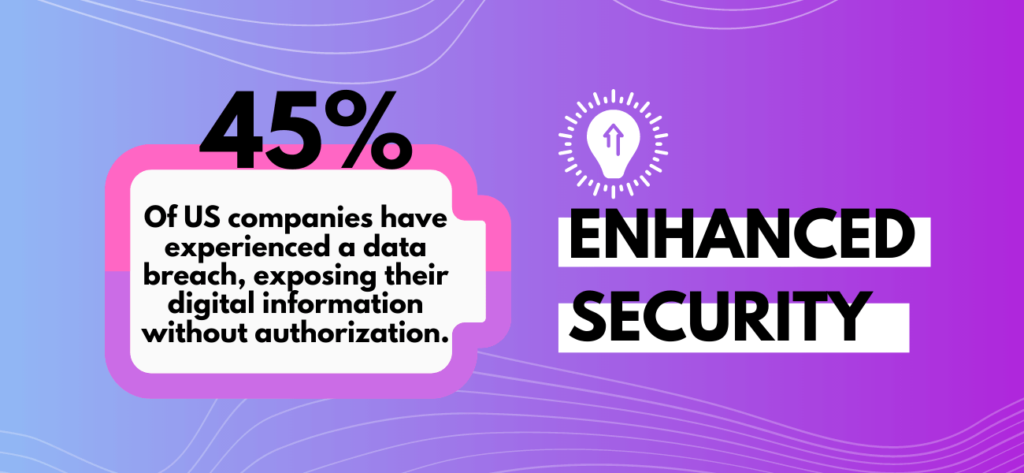
Another significant benefit of employee monitoring is enhanced security. Employee monitoring tools like employee monitoring software can help organizations detect and prevent security breaches, data leaks, and other unauthorized activities. For example, by monitoring employees’ internet usage, organizations can identify and block access to risky websites, preventing potential security threats.
3. Prevention of Insider Threats
Insider threats, such as employees stealing company data or other employee data, can be detrimental to an organization’s reputation and financial well-being. Monitoring employees can help detect and prevent such threats by identifying any suspicious behavior, such as unauthorized data access or downloads, and raising alerts for further investigation. By monitoring employees’ activities, organizations can mitigate the risk of insider threats and take necessary actions to prevent any potential harm to the company.
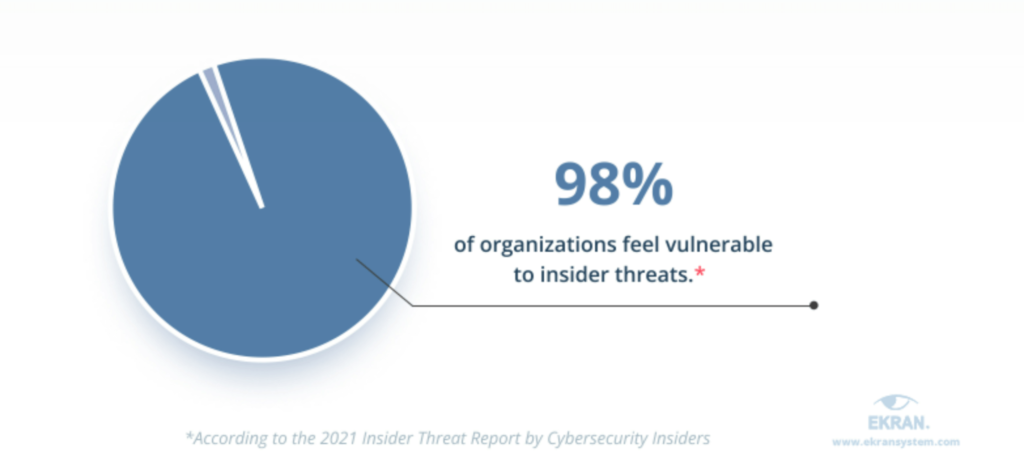
4. Identifying and Resolving Performance Issues
Employee monitoring can provide insights into employees’ performance and help identify any performance issues. By tracking employees’ activities, employers can assess their productivity levels, identify any gaps in skills or training, and provide appropriate feedback and coaching to improve performance. This can result in better employee performance, increased motivation, and improved overall organizational productivity.
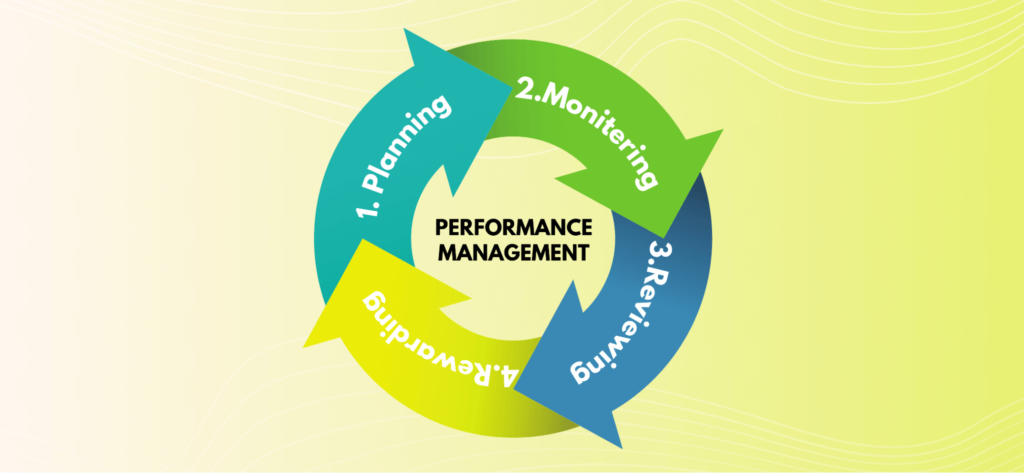
5. Time and Resource Management
As obvious, effective time and resource management is crucial for the success of any organization. Employee monitoring can help organizations optimize their resource allocation by identifying time-wasting activities, streamlining workflows, and identifying any bottlenecks or inefficiencies in processes. This can result in better time management, improved resource allocation, and increased overall productivity.
6. Remote Employee Monitoring
With the rise of remote work, employee monitoring has become even more relevant. Monitoring remote employees‘ activities can help organizations ensure that remote workers are engaged, productive, and adhering to company policies. It can also help remote employees stay focused and avoid distractions, leading to improved productivity and performance.
7. Employee Accountability
Employee monitoring promotes accountability in the workplace. By tracking employees’ activities, organizations can ensure that employees are fulfilling their responsibilities and meeting their targets.
As mentioned above, monitoring tools can provide data and metrics that can be used to measure employees’ performance and hold them accountable for their work. This can lead to a culture of accountability, where employees are motivated to perform at their best and meet their goals.
9. Protection of Company Reputation
The reputation of an organization is critical to its success. Employee monitoring can help protect the company’s reputation by identifying any activities that may pose a risk to the organization’s image or brand. Monitoring tools can detect any inappropriate behavior, such as sharing sensitive information, engaging in unethical activities, or engaging in harmful online activities, and take appropriate measures to address them. This can help organizations safeguard their reputation and maintain a positive image in the eyes of their customers, partners, and stakeholders.
10. Employee Training and Development
Employee monitoring can also be used as a tool for employee training and development. By tracking employees’ activities, organizations can identify areas where employees may need additional training or support.
Monitoring tools can provide insights into employees’ strengths and weaknesses, helping organizations tailor their training programs to address specific needs. This can result in improved employee skills, increased job satisfaction, and overall organizational success.
11. Enhanced Communication and Collaboration
Effective communication and collaboration are essential for organizational success. Employee monitoring can facilitate communication and collaboration among team members by providing insights into their activities and interactions.
Monitoring tools can help identify any communication gaps or breakdowns, enabling organizations to take corrective actions and improve team dynamics. This can result in better teamwork, increased innovation, and improved overall performance.
12. Addressing Insider Threats
Insider threats, such as employees leaking sensitive information or engaging in unethical activities, can pose a significant risk to organizations. Employee monitoring can help detect any suspicious activities or behavioral patterns that may indicate insider threats.
By monitoring employees’ activities, organizations can identify any potential red flags and take appropriate measures to prevent any harm to the company. This can include implementing security protocols, providing additional training, or taking legal actions when necessary.
13. Improved Compliance with Industry Regulations
Employee monitoring can help ensure that organizations comply with industry-specific regulations and legal requirements. Many industries, such as finance, healthcare, and telecommunications, are subject to strict regulations regarding data protection, privacy, and operational procedures. Monitoring tools can track and document employee activities to ensure that all processes are conducted according to these standards. This reduces the risk of non-compliance, which can result in costly fines and legal repercussions. By maintaining a record of compliance, organizations can demonstrate adherence to regulatory requirements during audits and inspections, thereby safeguarding their operations and reputation.
14. Better Workload Management and Balanced Work Distribution
Employee monitoring can also assist in managing workloads more effectively by providing insights into how tasks and responsibilities are distributed among employees. Monitoring tools can reveal which employees are overburdened with work and who might have the capacity to take on additional tasks. This enables managers to distribute work more evenly, preventing burnout and ensuring that all employees are utilized efficiently. By balancing workloads, organizations can improve overall productivity, employee satisfaction, and the quality of work, ultimately leading to a more harmonious and effective workplace environment.
Cons of Employee Excessive Monitoring
Despite its benefits, monitoring employees can have the following cons:
1. Invasion of Employee Privacy:
In a survey by the Society for Human Resource Management, 45% of employees reported feeling that their employer’s monitoring of their online activities was an invasion of privacy.
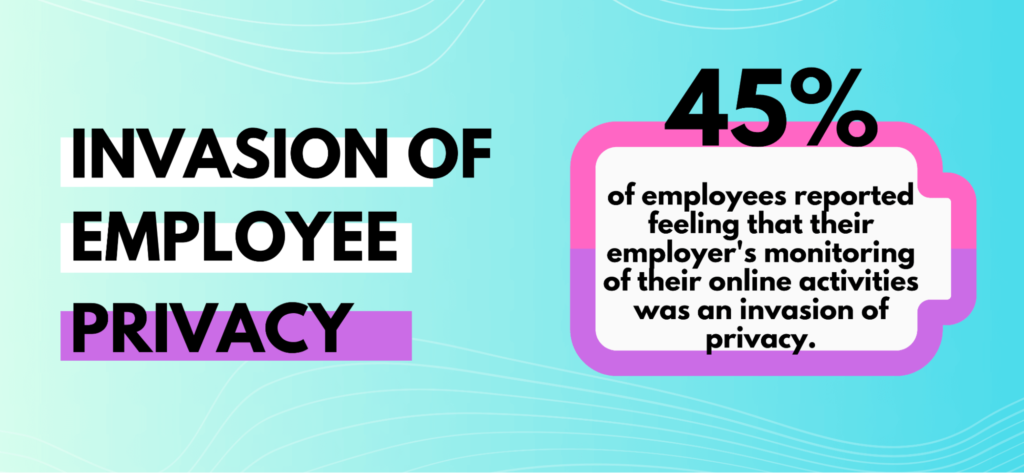
When employee monitoring is taken to an excessive level, it can intrude on the privacy of employees. Constant surveillance of their activities, both online and offline, can make employees feel uncomfortable and create a sense of mistrust, leading to decreased job satisfaction and morale.
2. Negative Impact on Employee Morale:
It is probably obvious that excessive monitoring can result in a decline in employee morale. Constant surveillance can make employees feel micromanaged and lack the autonomy and trust necessary for them to perform their best. This can lead to a decrease in motivation and engagement, ultimately affecting overall productivity and job satisfaction.
The American Civil Liberties Union (ACLU) reported that overly intrusive employee monitoring can lead to negative impacts on employee well-being, including increased stress and decreased job satisfaction.
3. Increased Stress and Anxiety:
Knowing that they are constantly being monitored can create stress and anxiety for employees. It can create a sense of pressure to constantly perform and fear of repercussions for minor mistakes or perceived lapses in productivity. This can lead to increased stress levels, decreased mental well-being, and potential burnout.
4. Potential for Breach of Employee Trust:
Excessive employee monitoring can erode the trust between employers and employees. When employees feel that their privacy is being invaded, it can damage the trust and relationship between them and their employer. This can result in decreased loyalty, commitment, and long-term retention of employees within the organization.
Organizations need to strike a balance between monitoring and respecting the privacy and autonomy of employees to avoid the potential negative consequences of excessive employee monitoring. Employers should implement monitoring practices that are fair, transparent, and aligned with legal and ethical standards to create a healthy work environment that fosters trust, engagement, and productivity.
Is Employee Monitoring Software Useful?
Employee monitoring software has become a valuable tool for businesses to track and manage employee activities in the workplace. With features such as time-tracking tools, website tracking, and video surveillance, employers can gain insights into employee productivity, time management, and online activities. However, it is important to strike a balance between monitoring and employee morale.
Excessive monitoring can negatively impact employee morale, leading to decreased job satisfaction and potentially higher employee turnover rates. Therefore, organizations need to implement an employee monitoring program that is fair, transparent, and respects employee privacy while also promoting productivity and efficiency in the workplace. Properly utilized, employee monitoring software can be an effective tool for organizations to optimize employee performance and achieve their business goals.
Frequently Asked Questions
The following questions are usually frequently asked:
1. Is Employee Monitoring Legal?
Yes, employee monitoring is legal in many jurisdictions, but organizations must comply with local laws and regulations. It is essential to obtain employees’ consent, clearly communicate the purpose and scope of monitoring, and follow all applicable legal requirements.
2. Can Employee Monitoring Improve Productivity?
Yes, employee monitoring can improve productivity by providing insights into employees’ activities, identifying performance issues, and optimizing resource allocation. However, it is important to implement monitoring practices that are fair, transparent, and aligned with employees’ rights.
3. How Can Organizations Address Employee Privacy Concerns In Employee Monitoring?
Organizations can address employee privacy concerns by obtaining employees’ consent, clearly communicating the purpose and scope of monitoring, and ensuring that the collected data is used solely for legitimate purposes. It is also important to comply with local laws and regulations related to employee privacy.
4. How Can Organizations Ensure A Balance Between Employee Monitoring And Employee Privacy?
Organizations can ensure a balance between employee monitoring and employee privacy by implementing transparent and fair monitoring practices. This includes obtaining employees’ consent, clearly communicating the purpose and scope of monitoring, and ensuring that the collected data is used solely for legitimate purposes. Organizations should also comply with local laws and regulations related to employee privacy and regularly review and update their monitoring policies to align with changing legal requirements and employee expectations.
In conclusion, the pros of employee monitoring can be significant for organizations in terms of productivity, security, communication, and ethical standards. However, it is essential to implement monitoring practices that are transparent, fair, and compliant with legal regulations to address employee privacy concerns. Organizations should strive to strike a balance between the advantages of employee monitoring and employees’ right to privacy, creating a positive work environment where employees feel respected, engaged, and motivated.


